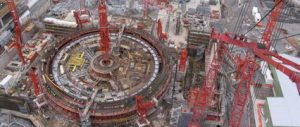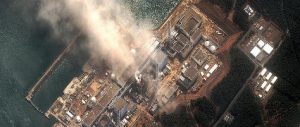Meng Si: What lessons do you think China can draw from Japan’s nuclear crisis?
Li Bo [director of NGO Friends of Nature]: Chinese media coverage of the tsunami and nuclear crisis has waned as time has passed, and this is very dangerous. Both in the affected area and in Japan as a whole, a deep revaluation of energy generation, energy policymaking, energy security and even the mode of development is quietly taking place. China should watch closely and learn. Facts win out over rhetoric. Japan is a nation of extremely cautious people, and that re-evaluation – and particularly the action that follows – is of more value than any empty preaching.
After the incident in Japan, the Chinese government quickly announced a suspension of approvals for new nuclear-power plants. During my recent visit to Germany, I heard representatives from many nations applaud the quick and high-profile way in which China took this cautious measure.
In April, I visited Germany’s Asse II nuclear-waste repository. Due to poor choice of location and management problems that arose early on, when there was no public oversight, it is now a dangerous and costly mess. If that kind of mistake can happen in a country with ample room for scientific and political debate, what cause do we have to believe that we in China can do better, that we won’t make mistakes?
MS: Tell us more about that nuclear-waste facility.
LB: The Asse nuclear-waste storage facility is a former salt mine, three hours’ journey west of Berlin. When it was built in the 1960s, this area was in West Germany. It’s estimated that over 5,000 barrels of nuclear waste are stored here.
The underground storage space is 800 metres deep and is set up like two large, underground buildings. The nuclear waste is stored 750 metres from the surface. We saw supporting pillars that were badly cracked because they are unable to bear the weight of the ceiling, with water seeping in.
MS: How are those problems going to be fixed?
LB: Workers are pumping out water daily. The water is treated to remove the radiation risk. They’re also constantly bringing in minerals containing salt to fill up tunnels and relieve some of the pressure on the underground spaces in order to delay or prevent cracking and collapse.
Every part of this process is incredibly complex. Large machines have to be broken down into parts and then reassembled 400 metres down the mine shaft.
At the same time, both temporary storage – the casing of many of the barrels is severely damaged – and a permanent home for the nuclear waste has to be found above ground.
Even optimistic estimates from officials indicate it will take at least eight years to remove all the waste. The project has had annual government funding in the billions of euros ever since the 1970s – it’s a bottomless pit.
MS: Why was this location chosen for nuclear-waste storage?
LB: Because radiation from the waste can spread via water, dry environments are typically chosen for storage. Originally, experts believed that the location was very dry and that there wouldn’t be any water inflow and that the salt deposits would act as a radiation block. So, it was proposed that the nuclear-waste storage facility be built there. It is now believed that the scientists didn’t fully check and examine their findings – a basic error that should not have occurred.
MS: What’s your opinion on the risks of “scientific policy-making”?
LB: Science is a constantly improving system of knowledge. What is currently seen as the peak of understanding will in time be replaced by new peaks. Tetracycline was found to turn teeth yellow, DDT caused unprecedented ecological problems. The inventors of nuclear power didn’t plan to cause disasters, but when we use a technology, we also need to protect ourselves from its potential dangers – to rigorously debate and examine the issues it throws up. Otherwise, problems may appear that we never anticipated.
But even then, there are risks that cannot be avoided – human risks. Regardless of how powerful our thinking and our technologies are, you cannot completely get rid of human errors. In the example of the Asse repository, the choice of location was such an error.
MS: How is public participation in Asse organised? What do you think about the use of nuclear power and public participation?
LB: Research in Germany has found much higher incidences of childhood leukaemia within a five-kilometre radius of nuclear facilities than in control regions. Science still can’t explain the link, but the facts are clear. So the locals are strongly opposed to the facilities. The authorities were willing to make changes to deal with that conflict and lack of trust, to help the locals understand, so the German environmental and nuclear authorities intervened to change the management and way the plant was run, and since around 2000, it has been open to the public. There are four or five visits a week, with 10 people each time. Anyone can visit. And nearby, staff from the environmental authorities are present to explain the nuclear waste management process to the public.
The public should be involved in deciding whether or not a nation needs nuclear power. That kind of participation lets people see what the costs of the choices are – costs that the whole of society will bear, not just the experts. If public education is done well, then people will understand the government’s choices and be willing to pay for them. When problems arise they will accept that, and together pay the costs of solving the problems. Public concern and fears often stem from ignorance. The more the public know, the more rational they will become.
MS: With energy demands and the need to cut greenhouse-gas emissions, is nuclear power an inevitable choice?
LB: The energy-demand crisis must not be allowed to hijack our full, open, transparent and scientific policymaking process. There are pressures from energy-saving and emissions-reduction needs, and from energy supply, and we should have effective measures to deal with those pressures. But that is no reason for rashly or hastily getting energy projects under way. We need to examine the real costs and risks of producing energy – including nuclear energy.
Germany recently closed seven of its nuclear-power stations. The public were told that the closures may result in rolling power cuts in some areas. But according to the German Green Party, the WWF and members of the German public I spoke to, there has been no real energy shortage as a consequence of the closures. Germany has started to exploit its own potential, and to reduce exports of electricity and increase imports.
How much influence do the power companies ultimately have over the amount of electricity a country produces? From Germany’s example, it’s not as much as you might think.
MS: Many experts argue that all renewable-energy sources have failings, and it will be hard for them to replace conventional energy sources.
LB: Many do stress the failings of renewable energy. It’s as if we don’t have the patience for a safer, more sustainable, less socially costly energy structure and energy policy. We just want fast, short-term results, leaving future generations to pay the safety costs.
From the outset, clean energy has issues with grid access, pricing, technology and so on. We always call it alternative, rather than mainstream. When I was in high school, I remember a teacher saying that one day we would do our shopping on the internet – that wasn’t mainstream back then, but it is very common now.
Alternatives don’t stay alternative forever, they can become mainstream. The way a country views alternative energy now reflects its expectations and confidence in the future.
MS: What attitude does Friends of Nature have towards China’s development of nuclear power?
LB: Nuclear power is, for the average member of the Chinese public, an unknown field – the information is either too technical to understand or there aren’t the channels for the public to learn about it. Friends of Nature also has this problem.
But through learning about Japan, Germany and Chernobyl, we’ve seen the importance of public participation and openness of information in this area. We are concerned about nuclear safety, the real costs of nuclear power, and the social and environmental costs of handling nuclear waste. We hope the government will do more research and trials in this field. We also hope public education will improve understanding of the operation of nuclear-power plants and their costs and benefits.
Meng Si is managing editor in chinadialogue’s Beijing office.
Homepage image from Dima Konsewitch shows a protest against nuclear-waste storage at Asse II.


